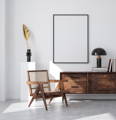The Mid-Century Modern Design Style
Emerging from the 1930s to the 1960s, the Mid-Century Modern design style is a timeless aesthetic that celebrates post-war optimism, functionality, and simplicity. This style, deeply rooted in the Modernist movement, transformed residential interior design with its forward-thinking approach. Central to Mid-Century Modern interiors is the emphasis on clean lines, organic forms, and minimal fuss. Furniture pieces are often raised on slender legs and is in rich woods like teak, walnut, and rosewood. Upholstery is in bold or muted hues, often incorporating geometric patterns or textures. Open floor plans, large windows, and an integration with nature are architectural hallmarks while decor is purposeful and uncluttered.
Functionality goes hand-in-hand with aesthetics. Every item, from lighting fixtures to storage solutions, embodies both practicality and visual appeal. The result is a harmonious blend of form and function, capturing the essence of an era while remaining evergreen in its appeal.

Mid-Century Modern Style Architecture
Characterized by seamless integration with the surrounding environment and a focus on simplicity, homes often feature clean lines, flat planes, and expansive windows. Open floor plans are common, enhancing spatial fluidity. Strong geometric shapes and an emphasis on horizontal and vertical lines dictate the structural form. The overall design often leans towards minimalism and functionality.
Expansive windows and sliding glass doors enhance indoor-outdoor connectivity.
Clean lines and flat planes define the structural aesthetic.
Open floor plans promote spatial fluidity and versatile living spaces.
Strong geometric forms, both horizontal and vertical, dominate the design.
The architecture emphasizes minimalism, functionality, and a symbiotic relationship with nature.

Mid-Century Modern Style Materials
The design champions natural materials and innovative advancements of the era. Rich woods like teak, walnut, and rosewood are frequently used for furniture, exuding warmth and sophistication. Plywood and plastic, both seen as revolutionary at the time, found their way into interiors, reflecting the innovative spirit. Metal, especially brushed steel and chrome, is used for accents and furniture frames. Glass, not just in windows but also in tabletops and decor, adds a touch of transparency and modernity.
Rich woods, particularly teak and walnut, dominate furniture pieces.
Plywood and plastics showcase the era's embrace of innovative materials.
Metals, like brushed steel and chrome, add sleekness and durability.
Expansive use of glass emphasizes transparency and open design.
The material palette reflects a blend of natural elements and mid-century technological advancements.

Mid-Century Modern Style Colors and Finishes
Mid-Century Modern color palettes embrace a mix of muted tones and vibrant hues. Earthy colors like browns, taupes, and olives are paired with bolder shades of orange, teal, and mustard. In terms of finishes, there's a balance between natural and polished. Wood often retains a matte or semi-gloss finish, highlighting its natural grain. Metals, whether brushed or polished, contrast the wood's texture, adding sleekness and shine to interiors.
Earthy tones form the base, complemented by vibrant pops of color.
Bold hues like mustard, teal, and orange reflect the era's optimism.
Wood finishes lean towards matte or semi-gloss, emphasizing natural grain.
Metals, from brushed steel to polished chrome, introduce contrast and modernity.
The palette and finishes together evoke a blend of organic warmth and sleek innovation.

Mid-Century Modern Style Furniture and Decor
Mid-Century Modern furniture is celebrated for its form-follows-function philosophy. Pieces often boast clean lines, organic shapes, and a notable absence of excess ornamentation. Iconic designs include the Eames chair, Noguchi table, and Saarinen tulip chair. Materials range from rich woods to innovative plastics and metals. Decor items are minimalist yet impactful: sunburst clocks, abstract sculptures, and geometric-patterned textiles.
Clean lines and organic shapes define the furniture, devoid of unnecessary frills.
Iconic designs from renowned designers, like Eames and Saarinen, are staples.
A mix of natural woods with innovative materials showcases design evolution.
Decor is minimalist, with items like sunburst clocks adding character.
Overall, the furniture and decor encapsulate the era's blend of functionality and avant-garde aesthetics.

Mid-Century Modern Style Lighting
Pendant lights with geometric or spherical shapes are iconic, often constructed from materials like metal, glass, or plastic. Arc floor lamps and sputnik chandeliers are other distinctive pieces that capture the spirit of the time. Table lamps, with sculptural bases and simple shades, showcase the movement's emphasis on clean lines and innovative materials. The lighting not only illuminates but also stands as a testament to the period's design genius.
Geometric pendant lights and sputnik chandeliers are emblematic of the style.
Arc floor lamps introduce drama while maintaining clean lines.
Sculptural table lamps blend art with function, often in innovative materials.
The choice of metals, from brass to chrome, reflects the era's technological advancements.
Every fixture, from design to material choice, underscores the balance between aesthetics and functionality.
